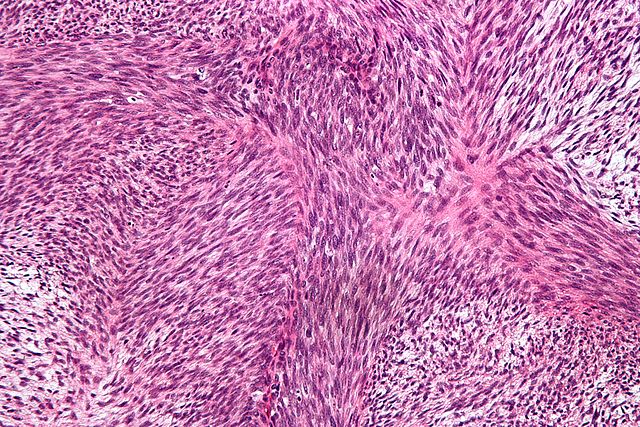Fibrosarcoma: Difference between revisions
(→Stage) |
|||
| Line 12: | Line 12: | ||
===Stage=== | ===Stage=== | ||
Fibrosarcoma | Fibrosarcoma may be classified into 3 stages based on grade and extent of lesion. | ||
*Stage I | *Stage I | ||
Stage IA: Low grade lesion that is confined to its anatomic compartment | Stage IA: Low grade lesion that is confined to its anatomic compartment | ||
Revision as of 15:22, 21 August 2015
|
WikiDoc Resources for Fibrosarcoma |
|
Articles |
|---|
|
Most recent articles on Fibrosarcoma Most cited articles on Fibrosarcoma |
|
Media |
|
Powerpoint slides on Fibrosarcoma |
|
Evidence Based Medicine |
|
Clinical Trials |
|
Ongoing Trials on Fibrosarcoma at Clinical Trials.gov Clinical Trials on Fibrosarcoma at Google
|
|
Guidelines / Policies / Govt |
|
US National Guidelines Clearinghouse on Fibrosarcoma
|
|
Books |
|
News |
|
Commentary |
|
Definitions |
|
Patient Resources / Community |
|
Patient resources on Fibrosarcoma Discussion groups on Fibrosarcoma Patient Handouts on Fibrosarcoma Directions to Hospitals Treating Fibrosarcoma Risk calculators and risk factors for Fibrosarcoma
|
|
Healthcare Provider Resources |
|
Causes & Risk Factors for Fibrosarcoma |
|
Continuing Medical Education (CME) |
|
International |
|
|
|
Business |
|
Experimental / Informatics |
Editor-In-Chief: C. Michael Gibson, M.S., M.D. [1]
Synonyms and keywords: Malignant fibromatous neoplasm, fibroblastic sarcoma
Overview
Fibrosarcoma (fibroblastic sarcoma) is a malignant tumor derived from fibrous connective tissue and characterized by immature proliferating fibroblasts or undifferentiated anaplastic spindle cells. Fibrosarcoma can be intramedullary or periosteal lesion of bone.
Classificaion
Grade
Fibrosarcoma may be classified according to degrees of differentiation into three subtypes: low grade malignancy (differentiated), intermediate malignancy and high grade malignancy (anaplastic)
Stage
Fibrosarcoma may be classified into 3 stages based on grade and extent of lesion.
- Stage I
Stage IA: Low grade lesion that is confined to its anatomic compartment
Stage IB: Low grade lesion that have extended outside of its compartment
- Stage II
Stage IIA: High grade lesion that is confined to its anatomic compartment
Stage IIB: High grade lesion that have extended outside of its compartment
- Stage III
lesions are any grade or anatomic site that have metastasized
Pathophysiology
Gross Pathology
The tumor is typically well demarcated but not encapsulated.
Microscopic Pathology
Tumor cells may resemble mature fibroblasts (spindle-shaped), secreting collagen, with rare mitoses. These cells are arranged in short fascicles which split and merge, giving the appearance of "fish bone". Poorly differentiated tumors consist in more atypical cells, pleomorphic, giant cells, multinucleated, numerous atypical mitoses and reduced collagen production. Presence of immature blood vessels (sarcomatous vessels lacking endothelial cells) favors the bloodstream metastasizing. The malignant cells are Characteristically arranged in a "herringbone" pattern.
 |
Epidemiology and Demographics
Fibrosarcoma makeup about 5% of all primary bone sarcomas. Fibrosarcoma is found most commonly around the knee in the proximal tibia and distal femur. It affects men and women equally.
Incidence
Fibrosarcoma is a rare disease that tends to affect approximately one among two million people annually.
Age
Patients of all age groups may develop Fibrosarcoma, but are most common between the third and sixth decades of life. In infants, fibrosarcoma is usually congenital. Infants presenting with fibrosarcoma usually do so in the first two years of their life.
Natural History, Complications, and Prognosis
Prognosis
Prognosis of Fibrosarcoma is dependent on the tumor grade. It is associated with a 5 year survival rates of 30% among patients with high grade medullary lesions and 50-80% in surface fibrosarcomas and low grade fibrosarcomas. Secondary sarcoma, presence of eccentric permeative lesions, primary tumor in the axial skeleton are associated with a particularly poor prognosis among patients with fibrosarcoma.
Risk Factors
Common risk factors in the development of Fibrosarcoma are preexisting benign lesions such as giant cell tumor, enchondroma, fibrous dysplasia, bizarre parosteal osteochondromatous proliferation or chronic osteomyelitis. Other risk factors include Paget's disease, radiation therapy, surgically treated fracture and infarction of bone.
Screening
There is no known screening test available for early diagnosis of Fibrosarcoma.
History and Symptoms
The most common symptoms of Fibrosarcoma include
- localized Pain
- swelling
- loss of range of motion.
Pain with weight-bearing that is relieved by rest and night pain may be observed. Many patients with fibrosarcoma neither feel sick nor experience classic symptoms of cancer such as weight loss and fatigue. Sometimes, patients with fibrosarcoma may present with pathologic fracture of affected bone.
Differential Diagnosis
Fibrosarcoma must be differentiated from other conditions that cause pain, swelling and Lesions that may appear similar to fibrosarcoma on radiological images such as
- Osteosarcoma
- chondrosarcoma
- leiomyosarcoma
- malignant fibrous histiocytoma
- Myofibromatosis
- Desmoplastic fibroma
Intra-osseous fibrosarcoma that affects the jaw must be differentiated from odontogenic sarcomas like
- Ameloblastic fibrodentinosarcoma
- Ameloblastic fibrosarcoma
- odontogenic carcinosarcoma
Diagnosis
X Ray
The radiological picture of Fibrosarcoma typically shows the osteolytic lesion with a permeative or moth-eaten appearance. Margins of lesion can range from well-demarcated to ragged appearance.
CT scan
The lungs are most common site of sarcoma metastasis.To determine if there is metastasis of the tumor to the lungs, computed tomography (CT) of the chest is performed at initial diagnosis.
MRI
Imaging of the entire bone with lesion is necessary to determine the lesions extended beyond the area delineated by X ray. The benefits of MRI Scans in Fibrosarcoma patients are the following
- Identify non-contiguous skip lesions that can arise within the same bone
- Determine the extent of bone marrow and soft tissue involvement
See also
References